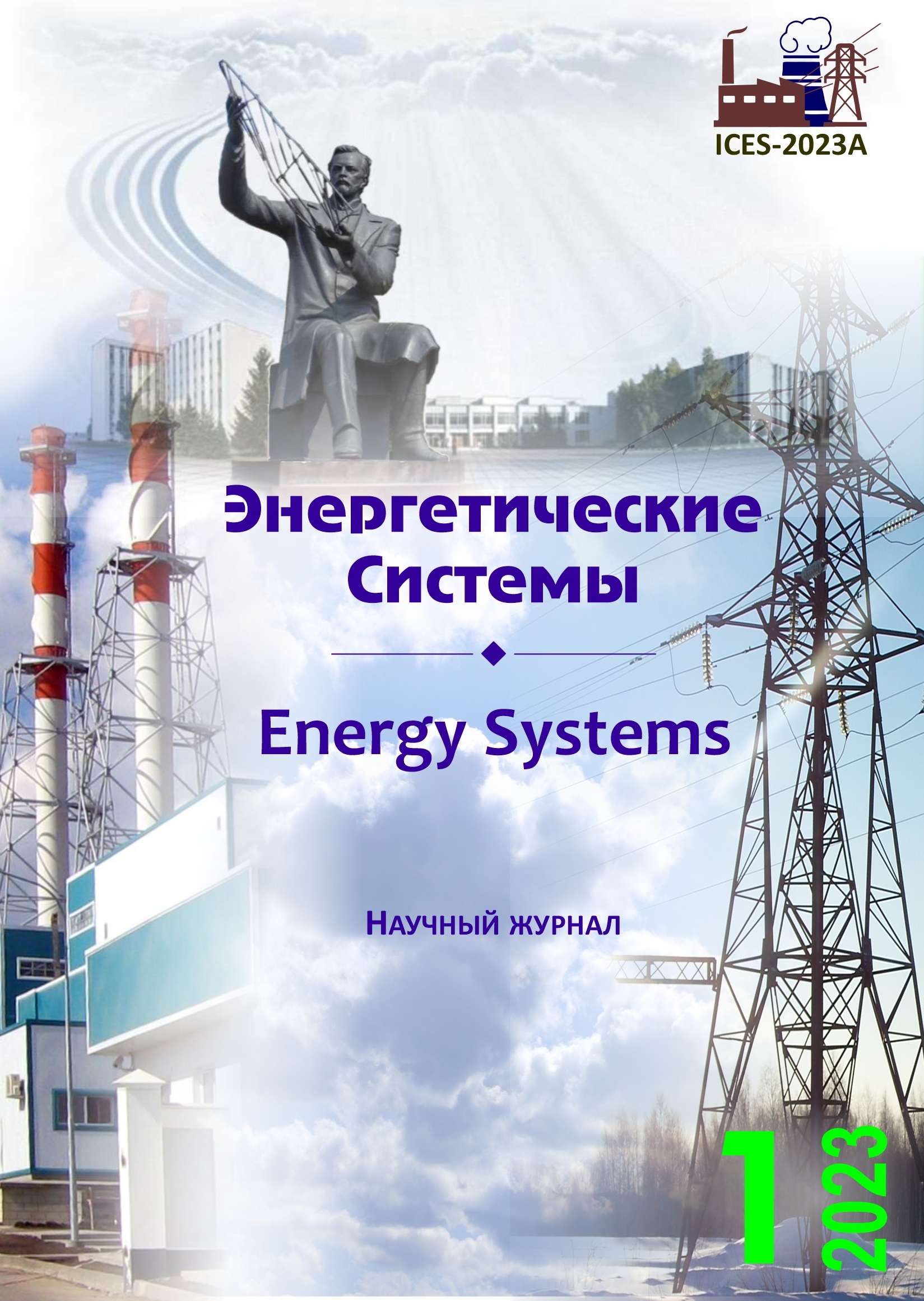Mono- and bimetallic pd-pt nanoparticles as an efficient tool for the intensification of transcrystalline hydrogen transport
Keywords:
palladium-containing membranes, nanostructured coatings, hydrogen permeability, hydrogen carriers, penta-twinned nanoparticlesAbstract
A technique has been developed for obtaining highly active Pd-Pt nanocatalysts on the surface of all-metal Pd-23%Ag membranes. These coatings were a large number of pentagonally structured Pd-Pt nanoparticles with an average size of about 100 nm, designed to intensify the process of hydrogen transport. By melting and rolling with intermediate annealing, palladium-silver foils 30 µm thick were obtained, which acted as the basis of the membranes. Surface modification was carried out by electrolytic deposition with a change in the parameters of the deposition current and the composition of the working solution. Classical methods made it possible to obtain spherical particles on the surface of thin palladium-silver films. However, a decrease in the deposition current density, compared to classical methods, and a clear ratio of components in the working solution with the addition of a surfactant made it possible to obtain coatings based on particles with a special geometry. The developed materials were studied in the processes of low-temperature (25 °C) hydrogen transport as diffusion membrane filters, where they demonstrated penetrating flux density values up to 0.42 mmol/s m2 at operating pressures up to 0.3 MPa. It has been established that the density values of the hydrogen penetrating flux through membranes modified with pentatwinned Pd-Pt particles are up to 2.1 times higher than through membranes with classical palladium black. These nanocatalysts based on pentatwinned Pd-Pt particles made it possible to significantly intensify hydrogen transport at low temperatures. The developed membrane materials can become the basis for both low-temperature devices, such as a fuel cell, a hydrogen compressor, and find application as diffusion filters in steam reforming reactors.
Metrics
References
ГОСТ
1. A review on the role, cost and value of hydrogen energy systems for deep decarbonisation / D. Parra, L. Valverde, F.J. Pino, M. Patel // Renewable and Sustainable Energy Reviews. 2019. Vol. 44. P. 279-294.
DOI: 10.1016/j.rser.2018.11.010
2. Hydrogen energy, economy and storage: Review and recommendation / J.O. Abe, A.P.I. Popoola, E. Ajenifuja, O.M. Popoola // International Journal of Hydrogen Energy. 2019. Vol. 44, № 29, P. 15072-15086.
DOI: 10.1016/j.ijhydene.2019.04.068
3. Natural gas–ammonia dual-fuel combustion in spark-ignited engine with various air–fuel ratios and split ratios of ammonia under part load condition / O. Sechul, P. Cheolwoong, K. Seonyeob et al. // Fuel. 2021. Vol. 290(2). P. 120095.
DOI: 10.1016/j.fuel.2020.120095
4. One-step electroplating of palladium–copper alloy layers on a vanadium membrane for hydrogen separation: Quick, easy, and low-cost preparation / N. Endo, N. Dezawa, Y. Komo, T. Maeda // International Journal of Hydrogen Energy. 2021. Vol. 46 (64). P. 32570-32576.
DOI: 10.1016/j.ijhydene.2021.07.114
5. On alloying and low-temperature stability of thin, supported PdAg membranes / G. Zeng, A. Goldbach, L. Shi, H. Xu // International Journal of Hydrogen Energy. 2012. Vol. 37 (7). P. 6012-6019. DOI: 10.1016/j.ijhydene.2011.12.126
6. Филиппов С. П., Ярославцев А. Б. Водородная энергетика: перспективы развития и материалы // Успехи химии. 2021. Т. 90, № 6. С. 627-643.
EDN: YBZBHB.
7. Paglieri S. N., Way J. D. Innovations in palladium membrane research // Separation and Purification Reviews. 2002. Vol. 31(1). P. 1-169.
DOI: 10.1081/SPM-120006115
8. Kikuchi E. Membrane reactor application to hydrogen production // Catalysis Today. 2000. Vol. 56(1). P. 97–101.
DOI: 10.1016/S0920-5861(99)00256-4
9. The influence of modifying nanoflower and nanostar type Pd coatings on low temperature hydrogen permeability through Pd-containing membranes / I. Petriev, P. Pushankina, S. Bolotin et al. // Journal of Membrane Science. 2021. Vol. 620. № 118894.
DOI: 10.1016/j.memsci.2020.118894
APA
1. Parra, D., Valverde, L., Pino, F.J., & Patel, M. A (2019). A review on the role, cost and value of hydrogen energy systems for deep decarbonization. Renewable and Sustainable Energy Reviews, 44, 279-294. http://dx.doi.org/10.1016/j.rser.2018.11.010
2. Abe, J. O., Popoola, A. P. I., Ajenifuja, E., & Popoola, O.M. (2019). Hydrogen energy, economy and storage: Review and recommendation. International Journal of Hydrogen Energy, 44(29) , 15072-15086. http://dx.doi.org/10.1016/j.ijhydene.2019.04.068
3. Sechul, O., Cheolwoong, P., Seonyeob, K., Yongrae, K., Young, C., & Changgi, K. (2021). Natural gas–ammonia dual-fuel combustion in spark-ignited engine with various air–fuel ratios and split ratios of ammonia under part load condition, Fuel, 290, 120095. http://dx.doi.org/10.1016/ j.fuel.2020.120095
4. Endo, N., Dezawa, N., Komo, Y., & Maeda, T. (2021). One-step electroplating of palladium–copper alloy layers on a vanadium membrane for hydrogen separation: Quick, easy, and low-cost preparation. International Journal of Hydrogen Energy, 46(64) , 32570-32576. https://doi.org/10.1016/ j.ijhydene.2021.07.114
5. Zeng, G., Goldbach, A., Shi, L., & Xu, H. (2012). On alloying and low-temperature stability of thin, supported PdAg membranes. International Journal of Hydrogen Energy, 37(7) , 6012-6019. http://dx.doi.org/10.1016/j.ijhydene.2011.12.126
6. Filippov, S. P., & Yaroslavcev, A. B. (2021). Hydrogen energy: development prospects and materials. Russian Chemical Reviews, 90(6), 627–643. https://doi.org/10.1070/RCR5014
7. Paglieri S. N., & Way J. D. (2002). Innovations in palladium membrane research. Separation and Purification Reviews, 31(1), 1-169. https://doi.org/10.1081/SPM-120006115
8. Kikuchi, E. (2000). Membrane reactor application to hydrogen production. Catalysis Today, 56 (1) , 97–101. http://dx.doi.org/10.1016/S0920-5861(99)00256-4
9. Petriev, I., Pushankina, P., Bolotin, S., Lutsenko, I., Kukueva, E., & Baryshev, M. (2021). The influence of modifying nanoflower and nanostar type Pd coatings on low temperature hydrogen permeability through Pd-containing membranes. Journal of Membrane Science, 620, 118894. http://dx.doi.org/10.1016/j.memsci.2020.118894
Downloads
Published
How to Cite
Issue
Section
Categories
URN
License
Copyright (c) 2023 G.A. Andreev, P.D. Pushankina, S.S. Djimak, I.S. Petriev

This work is licensed under a Creative Commons Attribution-NonCommercial-NoDerivatives 4.0 International License.


